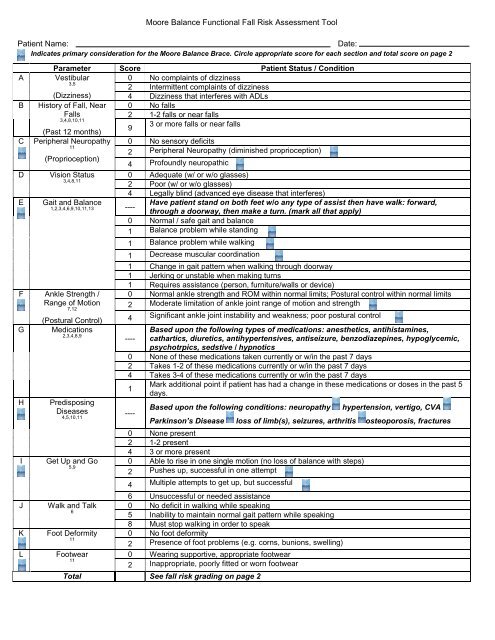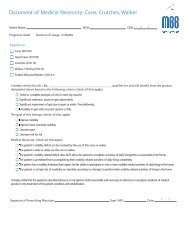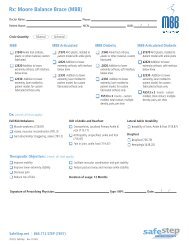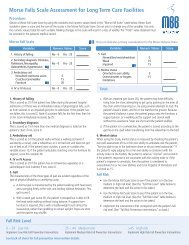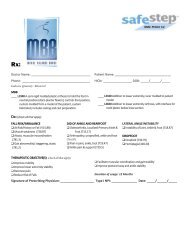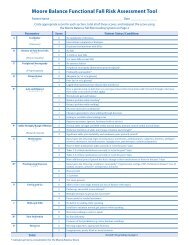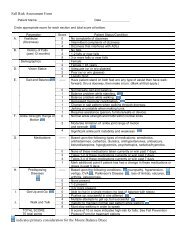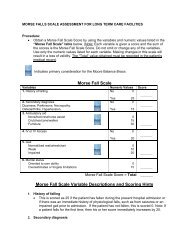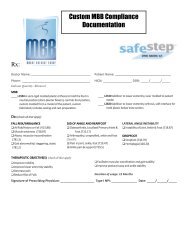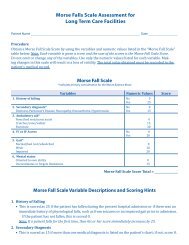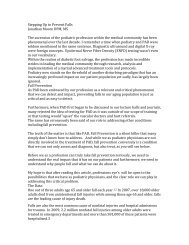Moore Balance Functional Fall Risk Assessment Tool Patient Name ...
Moore Balance Functional Fall Risk Assessment Tool Patient Name ...
Moore Balance Functional Fall Risk Assessment Tool Patient Name ...
Create successful ePaper yourself
Turn your PDF publications into a flip-book with our unique Google optimized e-Paper software.
<strong>Moore</strong> <strong>Balance</strong> <strong>Functional</strong> <strong>Fall</strong> <strong>Risk</strong> <strong>Assessment</strong> <strong>Tool</strong><br />
<strong>Patient</strong> <strong>Name</strong>:<br />
Date:<br />
Indicates primary consideration for the <strong>Moore</strong> <strong>Balance</strong> Brace. Circle appropriate score for each section and total score on page 2<br />
A<br />
B<br />
C<br />
D<br />
E<br />
Parameter Score <strong>Patient</strong> Status / Condition<br />
Vestibular<br />
0 No complaints of dizziness<br />
3,5<br />
2 Intermittent complaints of dizziness<br />
(Dizziness) 4 Dizziness that interferes with ADLs<br />
History of <strong>Fall</strong>, Near 0 No falls<br />
<strong>Fall</strong>s<br />
2 1-2 falls or near falls<br />
3,4,8,10,11<br />
9<br />
3 or more falls or near falls<br />
(Past 12 months)<br />
Peripheral Neuropathy<br />
11<br />
(Proprioception)<br />
Vision Status<br />
3,4,8,11<br />
Gait and <strong>Balance</strong><br />
1,2,3,4,6,9,10,11,13 ----<br />
F Ankle Strength /<br />
Range of Motion<br />
7,12<br />
G<br />
H<br />
I<br />
J<br />
K<br />
L<br />
(Postural Control)<br />
Medications<br />
2,3,4,8,9<br />
Predisposing<br />
Diseases<br />
4,5,10,11<br />
Get Up and Go<br />
5,9<br />
Walk and Talk<br />
6<br />
Foot Deformity<br />
11<br />
Footwear<br />
11<br />
0 No sensory deficits<br />
2 Peripheral Neuropathy (diminished proprioception)<br />
4 Profoundly neuropathic <br />
0 Adequate (w/ or w/o glasses)<br />
2 Poor (w/ or w/o glasses)<br />
4 Legally blind (advanced eye disease that interferes)<br />
Have patient stand on both feet w/o any type of assist then have walk: forward,<br />
through a doorway, then make a turn. (mark all that apply)<br />
0 Normal / safe gait and balance<br />
1 <strong>Balance</strong> problem while standing<br />
1 <strong>Balance</strong> problem while walking<br />
1 Decrease muscular coordination<br />
1 Change in gait pattern when walking through doorway<br />
1 Jerking or unstable when making turns<br />
1 Requires assistance (person, furniture/walls or device)<br />
0 Normal ankle strength and ROM within normal limits; Postural control within normal limits<br />
2 Moderate limitation of ankle joint range of motion and strength<br />
4 Significant ankle joint instability and weakness; poor postural control<br />
Based upon the following types of medications: anesthetics, antihistamines,<br />
---- cathartics, diuretics, antihypertensives, antiseizure, benzodiazepines, hypoglycemic,<br />
psychotrpics, sedstive / hypnotics<br />
0 None of these medications taken currently or w/in the past 7 days<br />
2 Takes 1-2 of these medications currently or w/in the past 7 days<br />
4 Takes 3-4 of these medications currently or w/in the past 7 days<br />
Mark additional point if patient has had a change in these medications or doses in the past 5<br />
1<br />
days.<br />
----<br />
Based upon the following conditions: neuropathy<br />
hypertension, vertigo, CVA<br />
Parkinson’s Disease loss of limb(s), seizures, arthritis osteoporosis, fractures<br />
0 None present<br />
2 1-2 present<br />
4 3 or more present<br />
0 Able to rise in one single motion (no loss of balance with steps)<br />
2 Pushes up, successful in one attempt<br />
4 Multiple attempts to get up, but successful<br />
6 Unsuccessful or needed assistance<br />
0 No deficit in walking while speaking<br />
5 Inability to maintain normal gait pattern while speaking<br />
8 Must stop walking in order to speak<br />
0 No foot deformity<br />
2 Presence of foot problems (e.g. corns, bunions, swelling)<br />
0 Wearing supportive, appropriate footwear<br />
2 Inappropriate, poorly fitted or worn footwear<br />
Total See fall risk grading on page 2
Grading of falls risk: Circle total score<br />
<strong>Fall</strong> <strong>Risk</strong> Category Total Points Recommendations<br />
∘ Low falls risk 0-9 Implement actions for identified individual risk<br />
factors, & recommend health promotion behavior<br />
to minimize future ongoing risk (eg – increased<br />
physical activity, medication assessment, good nutrition, footwear<br />
assessment, Podiatric specialist referral, home safety education).<br />
∘ High falls risk 10-20 Implement actions for identified individual risk<br />
factors, and implement additional actions for high<br />
falls risk (<strong>Fall</strong> Prevention Center referral, home safety assessment<br />
and education, medication assessment, footwear assessment,<br />
Physical/Occupational Therapy referral, <strong>Moore</strong> <strong>Balance</strong> Brace, other<br />
assistive devices as needed).<br />
∘ Extreme falls risk >20 Implement actions for identified individual risk<br />
factors, and implement additional actions for extreme risk<br />
(<strong>Fall</strong> Prevention Center referral, implementation of home<br />
modification devices [e.g. bathing, toileting and stairs] care giver<br />
education, medication assessment, footwear assessment,<br />
Physical/Occupational Therapy referral, <strong>Moore</strong> <strong>Balance</strong> Brace, other<br />
assistive devices as needed).


